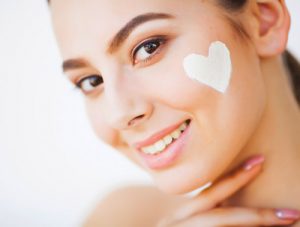
Knowledge is power! But how many of us just stare at our basket of beauty products pretending we know exactly how to use the countless creams, serums and oils?
I would say all of us, unless you’re Miss. Pimplepopper, or a dermatologist. For the rest of us common humans, we need to make sense of all these beauty products that are available to make us beautiful- that is, if we know how to make the best use of their benefits by correctly layering them on our face. What comes first, serum or toner? Before or after moisturizer? Face masks? And what about Retinol?
We asked Dr. Costi to share his tips for basic skin care layering, because if you don’t layer your products in the right way, or if you use the wrong moisturizer with the wrong toner, you could either render them totally ineffective or, even worse: you could irritate your face.
Ready? Let’s start with the basics.
At a glance, here are the main rules of product layering (from light to heavy).
Start with your most watery products, such as toners, serums and essences. Then come the heavier, more moisturizing ones like lotions, creams and then oils, followed by sunscreen.
Now here are the detailed steps on how to do it.

STEP 1: Cleanser
Before you start, make sure your face is clean: As per Dr. Costi, first use a micellar water or oil that dissolves the makeup, then follow with a gentle face wash drying your face gently. You need clean skin to absorb the ingredients you will layer.
STEP 2: Toner
This will prime your face for ingredients to be better absorbed.
You can choose any hydrating toner, which helps replenish the water your skin barrier lost when you washed and dried your face.
If you’ve got acne or oily skin, choose a toner containing chemical exfoliants to treat acne like BHA (beta hydroxy acid, like salicylic acid) or AHA (alpha hydroxy acid, like glycolic acid or lactic acid.)
If you’ve got dry skin, try water-soluble AHAs.
STEP 3: Serum
Serums are extremely concentrated nutrients, hydrators, and antioxidants that really amp up your skin health as soon as you apply them. So from now on, don’t skip on using them, because they are important.
In general, pick formulas with peptides for wrinkles to apply every day.
A Vitamin C serum will protect your skin from free radicals and inflammation during the day. But use it every other day if you have sensitive skin.
A hyaluronic acid serum will plump your skin and keep it hydrated while you sleep.
STEP 4: Eye cream
Eye creams tend to be lighter and thinner than face moisturizers, so make sure to apply them before your creams and oil. Tap on a simple, hydrating eye cream that’ll protect your under-eyes and repair your skin barrier.
STEP 5: Spot treatment
A spot treatment for zits, scars or dark spots should be applied at night when your body is resting and repairing itself. But if you’re gona use a retinoid, use your spot treatment in the morning. Make sure to tap it on before your moisturizer. We love products with Niacinamide which is anti-irritation.

Step 6: Moisturizer
A moisturizer not only infuses your skin with hydration but also helps trap in all the products underneath it to make the ingredients even more effective. It’s the only thing that’ll keep your skin barrier healthy.
Dr. Costi recommends a light hyaluronic moisturizer every morning. If you’re planning to wear makeup, put it on at least five minutes prior.
Then at night, use a moisturizer that is filled with hyaluronic acid, lipids and proteins that will reboot your skin.
If you’re getting into the anti-aging products, you can start with a product container a small dose of retinoids, which will be gentle on your skin.
STEP 7: Retinoids
Every dermatologist recommends this super-ingredient.
Retinol is not for daytime use because it breaks down in the sun- and shouldn’t be paired with some ingredients like vitamin C and salicylic acid.
“Retinoids” is the general term for vitamin A derivatives, like retinol and adapalene which speed up cell turnover for fresher, smoother, less wrinkled skin over time. According to Dr. Costi, you might wait up to six months to see results but in the meantime there are many additional benefits to this magic ingredient.
They trigger collagen production and cellular exfoliation, which means they’ll also fade dark spots, smooth scars, clear pores, prevent breakouts, and brighten skin.
If you’ve never used a retinoid product:
Make sure to start slow by trying it once a week. Then if your skin reacts well to it, try two nights a week for two weeks, then three nights a week for three weeks.
If your skin is easily irritated:
Apply a layer of moisturizer both 10 minutes before and after applying your retinol to reduce irritation without totally diluting the treatment.
OPTIONAL: STEP 8: Face oil
Face oils seal in all the ingredients and moisture to keep them from evaporating as quickly. On their own, oils aren’t actually that moisturizing, but when you layer them over products, they help increase your routine’s efficacy while also leaving skin soft and smooth. Just make sure to always apply them last to make your skin radiant. Put them on your dry areas after creams.
You can even use them for acne prone skin: oils like rose-hip and jojoba, can decrease excess oil. While marula and aloe oils can soothe sensitive skin.
Step 9: Sunscreen
Sunscreen is your last step in the morning. It sits on top of your skin, so if it goes on first, it prevents other ingredients from penetrating. Use it as the last step after your makeup.

Step10: Now be a good friend and share this blog with everyone you know!